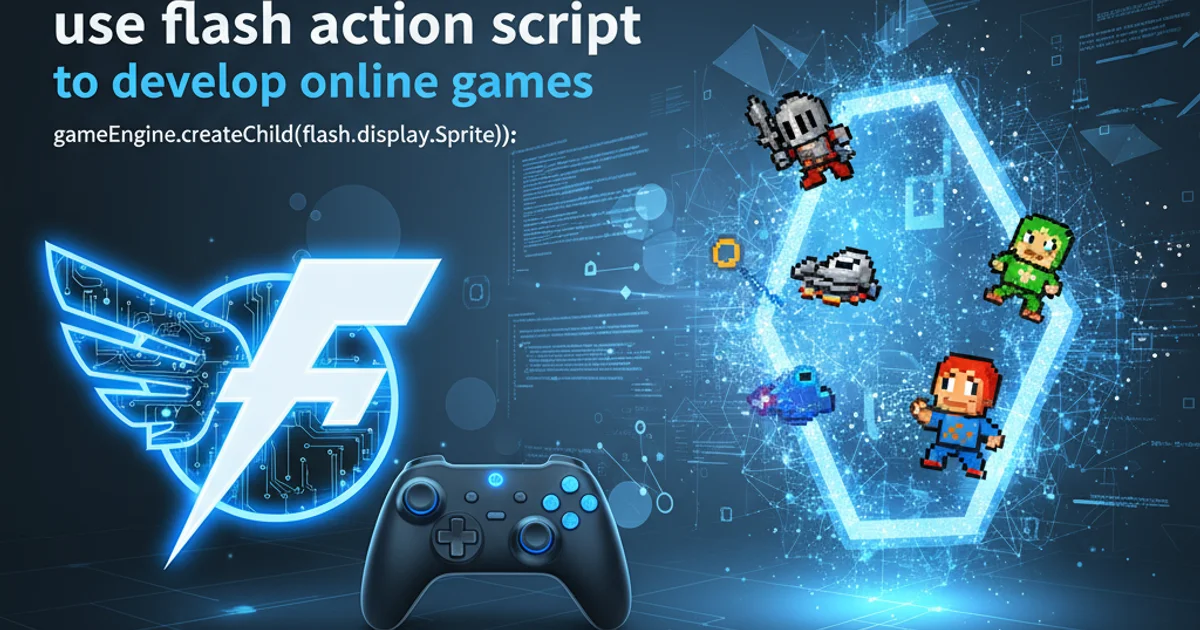use flash action script to develop online games
Categories:
Developing Online Games with Flash ActionScript: A Retrospective Guide

Explore the fundamentals of using Flash and ActionScript for creating interactive online games, covering core concepts, development workflows, and historical context.
Before the widespread adoption of HTML5 and JavaScript frameworks, Adobe Flash (and its scripting language, ActionScript) was the dominant platform for creating rich internet applications, including a vast array of online games. From simple arcade titles to complex RPGs, Flash provided a powerful environment for developers to bring their interactive visions to life. This article delves into the core aspects of developing online games using Flash ActionScript, offering insights into its architecture, game loop implementation, and event handling, while acknowledging its historical significance.
Understanding the Flash Game Development Environment
Flash game development revolved around the Flash IDE (Integrated Development Environment) and the ActionScript language. The IDE allowed for visual asset creation, animation, and scene management, while ActionScript provided the logic and interactivity. Games typically ran within the Flash Player plugin in web browsers, offering a consistent runtime environment across different operating systems. Key components included the Stage (the display area), Display Objects (visual elements like sprites, movie clips, and text fields), and the Event Model for handling user input and game events.
flowchart TD
A[Flash IDE] --> B{Design Assets & Scenes}
B --> C[Write ActionScript Code]
C --> D{Compile SWF File}
D --> E[Embed in HTML Page]
E --> F[User Plays in Flash Player]
F --> G{Event Handling & Game Logic}
G --> BTypical Flash Game Development Workflow
Core Concepts: Game Loop and Display List
At the heart of any Flash game was the game loop and the display list. The game loop was a continuous cycle responsible for updating game state, handling input, and rendering graphics. In ActionScript, this was often managed using Event.ENTER_FRAME listeners. The display list was a hierarchical structure of DisplayObject instances that determined what was visible on the screen and in what order. Understanding how to manipulate this list efficiently was crucial for performance and visual fidelity.
package {
import flash.display.Sprite;
import flash.events.Event;
public class SimpleGame extends Sprite {
private var player:Sprite;
public function SimpleGame() {
initGame();
}
private function initGame():void {
player = new Sprite();
player.graphics.beginFill(0xFF0000);
player.graphics.drawRect(0, 0, 50, 50);
player.graphics.endFill();
player.x = 100;
player.y = 100;
addChild(player);
// Start the game loop
addEventListener(Event.ENTER_FRAME, gameLoop);
}
private function gameLoop(event:Event):void {
// Update game state (e.g., move player)
player.x += 2;
// Basic boundary check
if (player.x > stage.stageWidth) {
player.x = -50;
}
// Render (Flash handles this automatically based on display list changes)
}
}
}
Basic ActionScript 3.0 Game Loop and Display Object Manipulation
Input Handling and Collision Detection
User interaction was primarily handled through keyboard and mouse events. ActionScript provided a robust event model that allowed developers to listen for specific input events and respond accordingly. Collision detection, a fundamental aspect of most games, could be implemented using various techniques, from simple bounding box checks to more complex pixel-perfect collision algorithms. The choice of method often depended on the game's complexity and performance requirements.
package {
import flash.display.Sprite;
import flash.events.KeyboardEvent;
import flash.ui.Keyboard;
public class InputExample extends Sprite {
private var player:Sprite;
public function InputExample() {
player = new Sprite();
player.graphics.beginFill(0x0000FF);
player.graphics.drawRect(0, 0, 30, 30);
player.graphics.endFill();
player.x = 50;
player.y = 50;
addChild(player);
stage.addEventListener(KeyboardEvent.KEY_DOWN, onKeyDown);
stage.addEventListener(KeyboardEvent.KEY_UP, onKeyUp);
}
private function onKeyDown(event:KeyboardEvent):void {
switch (event.keyCode) {
case Keyboard.LEFT:
player.x -= 5;
break;
case Keyboard.RIGHT:
player.x += 5;
break;
case Keyboard.UP:
player.y -= 5;
break;
case Keyboard.DOWN:
player.y += 5;
break;
}
}
private function onKeyUp(event:KeyboardEvent):void {
// Handle key release if needed
}
// Simple bounding box collision check
public function checkCollision(obj1:Sprite, obj2:Sprite):Boolean {
return obj1.getBounds(this).intersects(obj2.getBounds(this));
}
}
}
Handling Keyboard Input and Basic Collision Detection